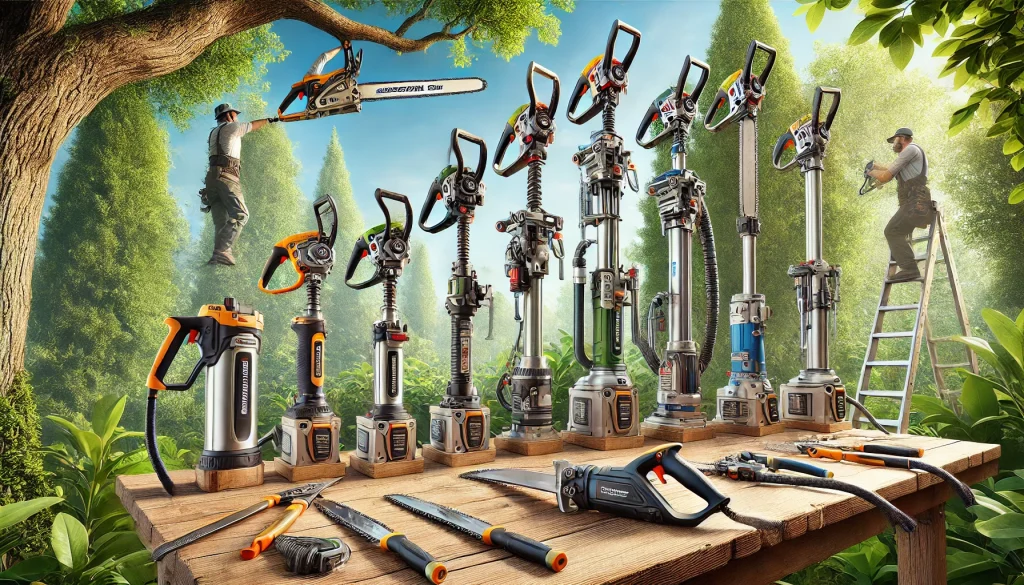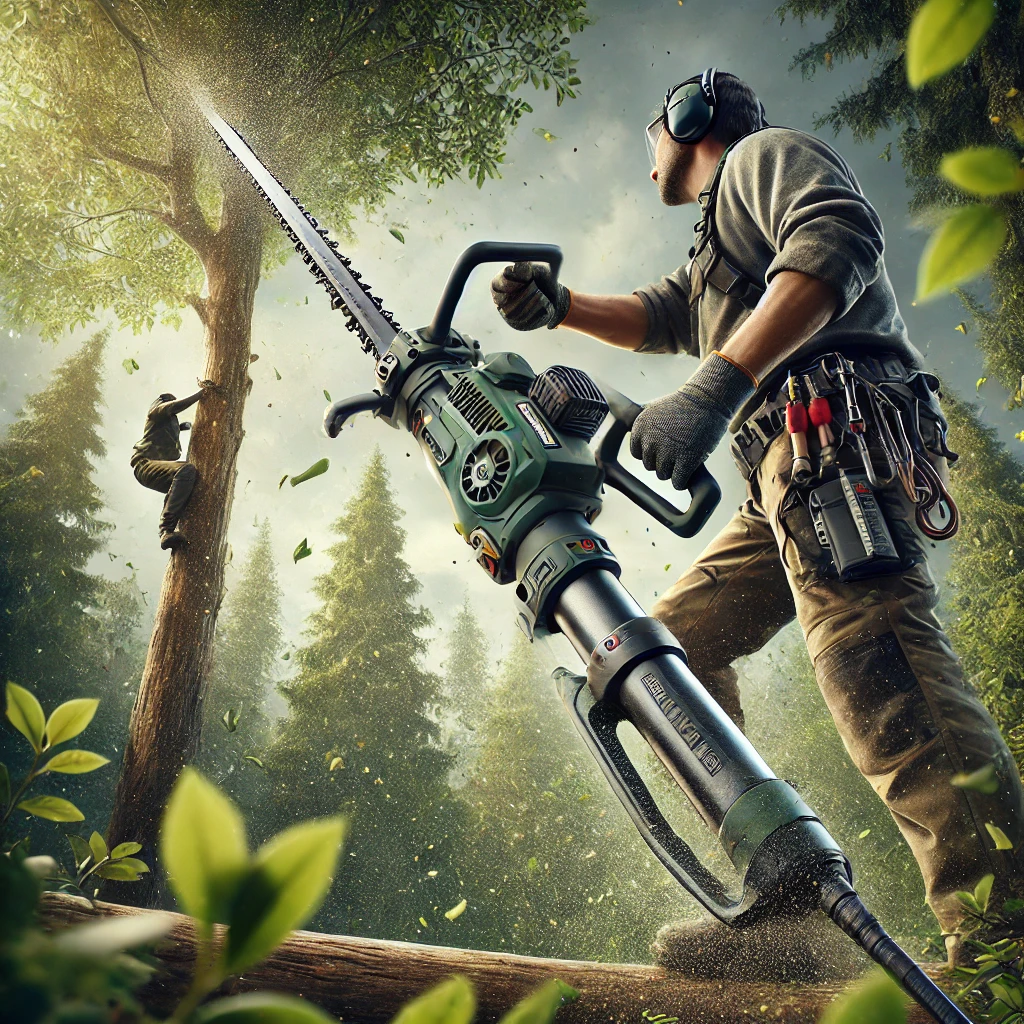When it comes to trimming trees and cutting through tough branches, hydraulic pole saws are a game-changer. These powerful tools allow you to reach higher branches effortlessly, making them an essential part of any homeowner’s or professional arborist’s toolkit. In this article, we’ll walk you through the top 10 best hydraulic pole saws available in 2025, helping you choose the ideal tool for your cutting needs.
Table of Contents
What is a Hydraulic Pole Saw?
A hydraulic pole saw is a specialized saw that utilizes hydraulic power to operate a chain saw at the end of a long pole. Unlike traditional manual or electric pole saws, hydraulic pole saws rely on the power of hydraulics, making them more efficient and capable of cutting through thicker branches with minimal effort. These saws are especially beneficial for tasks that require working at height, reducing the need for ladders or scaffolding.
Why Choose a Hydraulic Pole Saw?
- Effortless Cutting Power: Hydraulic pole saws provide exceptional cutting power, allowing you to tackle tough branches with ease.
- Long Reach: With the extended pole, you can easily reach branches high in trees without needing a ladder.
- Increased Safety: The hydraulic mechanism reduces the strain on your body and minimizes the risk of accidents that can occur with manual tools.
- Durability and Longevity: Hydraulic pole saws are built to withstand heavy-duty tasks, making them a reliable investment for both professionals and homeowners.
Pros
Cons
Key Features to Consider When Buying a Hydraulic Pole Saw
Before diving into our top picks, let’s look at some important factors to consider when choosing the best hydraulic pole saw:
- Length of Pole: A longer pole provides better reach, but ensure it’s still manageable in terms of weight.
- Power Source: Best hydraulic pole saws can be powered by different types of engines, such as gasoline or electric-powered units. Choose one that suits your needs and preferences.
- Bar Length: A longer bar allows for cutting thicker branches, while a shorter bar might offer more maneuverability for delicate work.
- Weight: The weight of the pole saw can affect how easy it is to control, so choose one that feels comfortable to handle for extended periods.
- Ease of Maintenance: Check whether the pole saw comes with features that make maintenance easier, such as easy-to-replace chains and air filters.
Top 10 Best Hydraulic Pole Saws for Effortless Cutting

Here are our top 10 hydraulic pole saws, each offering unique features and performance to suit a variety of needs:
1. Husqvarna 525P4S Professional Pole Saw
- Best for: Professional Arborists
- Key Features: With a 12-foot reach and a powerful 25cc engine, the Husqvarna 525P4S offers exceptional cutting power and is ideal for professional use. Its ergonomic design makes it easy to handle for extended periods.
- Pros: Lightweight, long reach, excellent cutting performance.
- Cons: Slightly higher price point for residential use.
2. Echo PPT-2620 Power Pruner
- Best for: Residential Use
- Key Features: Featuring a 25.4cc engine and a 12-foot reach, this pole saw is perfect for residential tree trimming tasks. Its lightweight design ensures comfort during use.
- Pros: Easy to start, lightweight, durable.
- Cons: Shorter reach compared to other models.
3. Greenworks 20672 8.5-Inch Cordless Pole Saw
- Best for: Eco-Friendly Users
- Key Features: Powered by a 40V battery, the Greenworks 20672 is an electric hydraulic pole saw designed for lighter jobs. It’s ideal for homeowners looking for an environmentally friendly option without sacrificing power.
- Pros: Quiet operation, zero emissions, easy to use.
- Cons: Battery life may not be sufficient for long, intense tasks.
4. WORX WG309 8 Amp 10-Inch Corded Pole Saw
- Best for: Budget-Conscious Buyers
- Key Features: This corded pole saw comes with an 8-amp motor and a 10-inch bar, making it a great option for light to moderate cutting tasks. Its easy assembly and budget-friendly price make it ideal for first-time users.
- Pros: Affordable, easy to use, good for smaller jobs.
- Cons: Limited by cord length, not ideal for large-scale tasks.
5. Ryobi RY43160 10-Foot Gas-Powered Pole Saw
- Best for: Heavy-Duty Tasks
- Key Features: With a 30cc engine and a 10-foot reach, the Ryobi RY43160 is a robust pole saw that can handle heavy-duty trimming with ease. It’s designed for both residential and light commercial use.
- Pros: High power output, durable construction.
- Cons: Slightly heavier than other models.
6. Craftsman CPES2000 20-Volt Cordless Pole Saw
- Best for: Convenience and Mobility
- Key Features: With a 20V lithium-ion battery and an 8-inch bar, this cordless pole saw is perfect for small jobs and quick trimming. Its lightweight design makes it easy to carry and maneuver.
- Pros: Cordless, lightweight, easy to store.
- Cons: Limited reach and cutting power for larger branches.
7. Makita XNU02Z 18V X2 LXT Cordless Pole Saw
- Best for: Professional Contractors
- Key Features: The Makita XNU02Z combines two 18V lithium-ion batteries for increased power, making it a great option for professionals. Its 10-inch bar and low vibration ensure smooth and comfortable operation.
- Pros: Cordless, high cutting power, low vibration.
- Cons: Requires two batteries for optimal performance.
8. Stihl HT 103 Telescoping Pole Saw
- Best for: Versatility
- Key Features: The Stihl HT 103 features a telescoping pole that extends up to 12 feet, offering maximum reach for tree trimming. Its efficient engine and quality construction make it a reliable choice for a variety of users.
- Pros: Telescoping pole, excellent cutting performance.
- Cons: Higher price point.
9. Poulan Pro PR28PS 28cc Gas Pole Saw
- Best for: Budget-Friendly Professionals
- Key Features: Equipped with a 28cc engine and a 10-foot reach, this pole saw offers great value for professional-grade work. It’s designed to handle tough cutting jobs at an affordable price.
- Pros: Powerful engine, affordable.
- Cons: Slightly heavier, requires more maintenance.
10. Homelite UT43120A 10-Foot Pole Saw
- Best for: Homeowners with Small Yards
- Key Features: This affordable pole saw comes with a 6-amp motor and 10-foot reach, ideal for homeowners with smaller trees and light trimming needs. It’s lightweight and easy to use, even for beginners.
- Pros: Affordable, lightweight, easy to assemble.
- Cons: Limited cutting power, not for heavy-duty tasks
You may also like
Electric vs. Hydraulic Saws: Which Offers Better Performance?

When it comes to cutting tools, two of the most popular types are electric saws and hydraulic saws. Both offer unique advantages depending on the job at hand, but choosing between them can be a challenge. In this article, we’ll compare electric saws vs hydraulic saws and help you decide which offers better performance for your needs.
Understanding Electric Saws
Electric saws are powered by electricity, either from a cord or a battery, depending on the model. They are widely used for a range of tasks, from home DIY projects to professional construction work. These saws are known for their ease of use and relatively low maintenance.
Key Features of Electric Saws
- Power Source: Electric saws typically run on 120V or 240V power (corded) or rechargeable batteries (cordless).
- Portability: Cordless electric saws are portable and great for light to medium-duty cutting tasks.
- Ease of Operation: Most electric saws are user-friendly, with easy startup and minimal effort required during operation.
- Noise and Vibration: Electric saws tend to be quieter and produce less vibration than hydraulic models, making them more comfortable to use for extended periods.
Pros of Electric Saws
- Lightweight: Electric saws, especially cordless models, are generally lighter and easier to handle.
- Low Maintenance: They require less maintenance compared to hydraulic saws. There’s no need to worry about oil changes or hydraulic fluid levels.
- Cost-Effective: Electric saws are typically more affordable than hydraulic models, especially the entry-level models.
- Environmentally Friendly: Cordless electric saws run on rechargeable batteries, making them a more eco-friendly option compared to gas-powered or hydraulic tools.
Cons of Electric Saws
- Limited Power for Heavy Tasks: While electric saws are suitable for light to medium-duty tasks, they might struggle with heavy-duty cutting, especially with thicker branches or logs.
- Battery Life: For cordless models, battery life can be a limiting factor, and longer tasks might require multiple battery charges.
- Cord Length Restrictions: Corded models limit mobility, especially if you’re working far from a power outlet.
What Are Hydraulic Saws?
Hydraulic saws, on the other hand, rely on hydraulic power to perform heavy-duty cutting tasks. They are commonly used in industries like construction, forestry, and demolition due to their exceptional cutting ability. The hydraulic system provides more cutting force, making it the go-to choice for tough jobs.
Key Features of Hydraulic Saws
- Power Source: best hydraulic best hydraulic pole saws are powered by a hydraulic system, usually connected to a gas-powered engine or a separate hydraulic power unit.
- Heavy-Duty Performance: These saws are built to handle tough cutting tasks, from large tree branches to metal or concrete in industrial applications.
- Longer Reach: Hydraulic pole saws can have an extended reach, allowing users to cut at heights without the need for ladders.
- High Cutting Force: The hydraulic mechanism offers substantial force, allowing these saws to cut through dense and tough materials with ease.
Pros of Hydraulic Saws
- Superior Cutting Power: Hydraulic saws offer greater cutting force, making them ideal for tougher jobs like cutting through thick wood, metal, or concrete.
- Longer Reach: With a hydraulic pole saw, you can reach higher branches or difficult spots without ladders or scaffolding.
- Durability: Hydraulic saws are built for heavy-duty use and can handle a variety of demanding tasks over a long lifespan.
- Consistency: Hydraulic saws provide consistent, high-performance cutting without overheating, making them perfect for industrial applications.
Cons of Hydraulic Saws
- Heavy and Bulky: best hydraulic pole saws are generally heavier than electric saws, making them less portable.
- Higher Maintenance: The hydraulic system requires regular maintenance, including fluid checks and replacements, which can add to the overall cost.
- Noise and Vibration: Hydraulic saws tend to be louder and produce more vibration than electric models, which can be uncomfortable for the user.
- Cost: Due to their robust construction and heavy-duty performance, hydraulic saws are often more expensive than electric saws.
Electric vs. Hydraulic Saws: Which Offers Better Performance?

Let’s now break down the comparison based on performance:
Cutting Power
- Hydraulic Saws: These offer superior cutting power, making them perfect for tough, dense materials like thick tree trunks, concrete, or metal. They provide consistent cutting force and can handle larger, tougher tasks without slowing down.
- Electric Saws: Electric saws are ideal for lighter to medium-duty cutting. While they can cut through smaller branches or softwood, they might not provide the same power for tougher materials.
Portability and Ease of Use
- Electric Saws: Cordless electric saws are lightweight, portable, and easy to maneuver. They are great for DIY tasks around the house or garden and don’t require a lot of setup or maintenance.
- Hydraulic Saws: These are heavier and bulkier, especially when using hydraulic pole saws or gas-powered models. The added weight and size can make them less ideal for small jobs or tasks requiring high mobility.
Maintenance
- Electric Saws: These require minimal maintenance. The main upkeep involves keeping the blades sharp and ensuring the battery is charged (for cordless models).
- Hydraulic Saws: best hydraulic pole saws require more maintenance, including fluid checks and filter changes. Over time, the hydraulic system may also need repairs, making them more expensive to maintain.
Cost
- Electric Saws: Generally more affordable, electric saws come in a wide range of price points, making them a good choice for budget-conscious consumers.
- Hydraulic Saws: These are typically more expensive due to their robust design and heavy-duty capabilities. The initial investment is higher, and maintenance costs can add up over time.
Suitability for Different Tasks
- Electric Saws: Best for light to medium-duty cutting tasks like trimming smaller trees, cutting firewood, or basic DIY projects.
- Hydraulic Saws: Ideal for heavy-duty work, such as large-scale tree removal, cutting through thick metal or concrete, or when a long reach is required.
FAQs
1. What is a hydraulic pole saw?
A hydraulic pole saw is a cutting tool powered by hydraulic pressure, designed for heavy-duty pruning and trimming tasks.
2. Who should use a hydraulic pole saw?
Hydraulic pole saws are ideal for professionals like arborists, landscapers, and utility workers who handle extensive cutting jobs.
3. What makes hydraulic pole saws different from electric or gas models?
They offer more power and durability, making them suitable for demanding tasks, but require a hydraulic power source.
4. Are hydraulic pole saws safe to use?
Yes, when used correctly with appropriate safety gear like gloves, helmets, and protective eyewear.
5. Can I use a hydraulic pole saw at home?
Hydraulic pole saws are better suited for professional or large-scale work, but homeowners with extensive properties may find them beneficial.
Final Thoughts
Choosing the best hydraulic pole saws depends on your specific needs—whether you’re a homeowner looking for a light-duty model or a professional in need of something more powerful. All of the options listed here provide great value and excellent performance for various tasks. Always ensure that the best hydraulic pole saws you choose aligns with your cutting requirements, reach preferences, and budget.
By considering these top picks, you’ll be able to make an informed decision that will make your tree trimming tasks effortless and efficient!



Leave a Reply